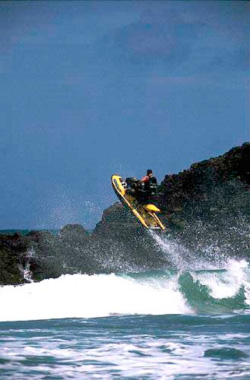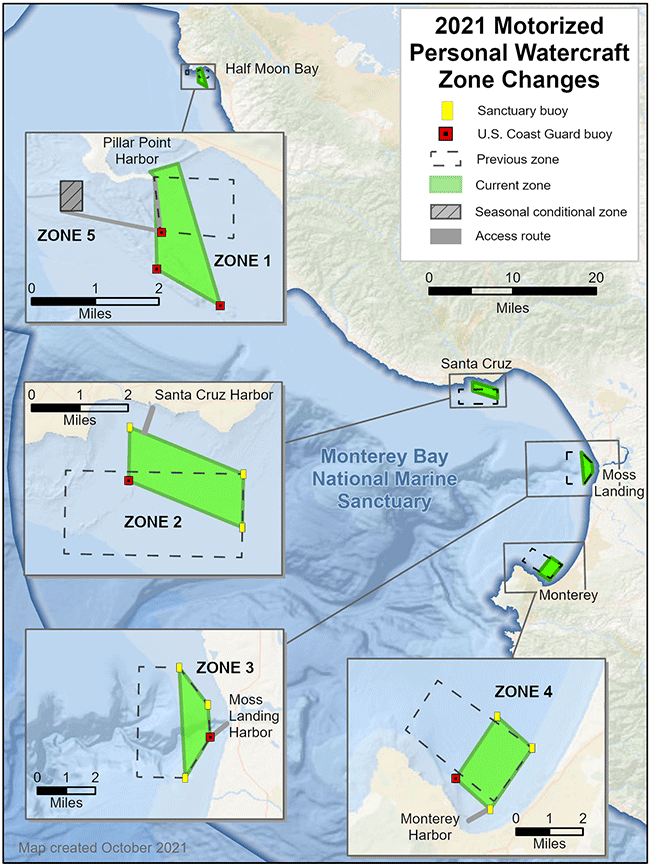Resource Issues: Motorized Personal Watercraft
Introduction
Motorized Personal Watercraft (MPWC) are small, fast, and highly maneuverable craft that possess unconventionally high thrust capability and horsepower relative to their size and weight. This characteristic enables them to make sharp turns at high speeds and alter direction rapidly, while maintaining controlled stability. Their small size, shallow draft, instant thrust, and "quick reflex" enable them to operate closer to shore and in areas that would commonly pose a hazard to conventional craft operating at comparable speeds. Many can be launched across a beach area, without the need for a launch ramp. Most MPWC are designed to shed water, enabling an operator to roll or swamp the vessel without serious complications or interruption of vessel performance. The ability to shunt water from the load carrying area exempts applicable MPWC from Coast Guard safety rating standards for small boats. MPWC are often designed to accommodate sudden separation and quick remount by a rider. MPWC are not commonly equipped for night operation and have limited instrumentation and storage space compared to conventional vessels. MPWC propelled by a directional water jet pump do not commonly have a rudder and must attain a minimum speed threshold to achieve optimal maneuverability. Most models have no steerage when the jet is idle.
 The majority of MPWC currently operated within Monterey Bay National Marine Sanctuary (MBNMS) are compact water jet-propelled craft that shed water from the passenger spaces. Larger size models are preferred in the high-energy ocean environment for increased power, range, and towing ability. MPWC are often operated in pairs or groups for camaraderie and improved safety.
The majority of MPWC currently operated within Monterey Bay National Marine Sanctuary (MBNMS) are compact water jet-propelled craft that shed water from the passenger spaces. Larger size models are preferred in the high-energy ocean environment for increased power, range, and towing ability. MPWC are often operated in pairs or groups for camaraderie and improved safety.
Assessments of MPWC impacts indicate that unrestricted access to all reaches of MBNMS by such craft would pose an unacceptable threat to wildlife and other ocean users. MPWC commonly accelerate and decelerate repeatedly and unpredictably, and travel at rapid speeds directly toward shore, while motorboats generally slow down as they approach shore. MPWC are often operated repeatedly off favored beaches or surf breaks. Thus wildlife disturbance impacts from MPWC tend to be more severe than those from motorboat use, due to repeated disruptions and accumulated impacts in nearshore areas. By contrast, conventional motorboats typically transit through areas at steady speeds and bearings, limiting the duration and intensity of their impacts to any given area. To prevent the disturbance of wildlife and other nearshore users, most MPWC have been restricted within protected marine areas adjacent to, or overlapping MBNMS (e.g. the Gulf of the Farallones National Marine Sanctuary and nearshore areas of the Golden Gate National Recreation Area, Marin County, California State Parks, and the City of Santa Cruz). Current MBNMS management of MPWC is consistent with actions taken in these jurisdictions.
To help protect sanctuary habitats and sensitive marine life, operation of motorized personal watercraft within MBNMS has been restricted to five designated zones and access routes (click here for a map) within the Sanctuary. Title 15, Code of Federal Regulations, Section 922.132(a)(7) states what is prohibited. The boundaries for the authorized MPWC operating zones are described in detail in Appendix E to the regulation noted above. Motorized personal watercraft may launch only within the identified harbors and must proceed directly to the operating zone outside each harbor through the specified access route. Zone boundaries are marked by buoys and navigation aids.
Zone 5 at the Mavericks surf break in Half Moon Bay is only open when official High Surf Advisories are in effect for San Mateo County during the months of December, January, and February. For more information about the Mavericks zone, click here.
Additional Resources:

